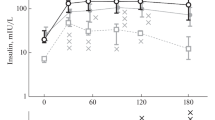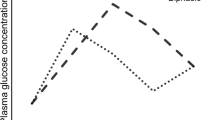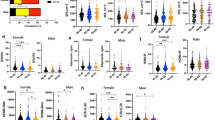Abstract
An important and still controversial issue is the role played by the aging process itself in the metabolic alterations observed in aged people. We previously reported that a group of normal elderly people exhibited glucose disposal comparable to that of young controls. In the present study we investigated the effect ofage on beta-cell secretion, by analyzing C-peptide measurements. Ten elderly men (E, 70 ± 2 years) with normal oral glucose test and ten young subjects (Y, 27 ± 1 years) with matching ideal body weight formed the study group. They were studied under highly dynamic conditions by means of a 0.3 g/kg i. v. glucose tolerance test. Fasting glucose and insulin were not different in the two groups (Y: 87 + 2 mg/dl, E: 88 ± 3, p >0.1; Y: 50 ± 7 pM, E: 36 ± 7, p >0.05). Glucoseinsulin data set was analyzed by means of the minimal model of glucose disappearance which provided two parameters for every individual, yielding a quantitative description of glucose utilization: i.e., SI the index of insulin sensitivity, and SG, the fractional glucose disappearance at basal insulin (glucose effectiveness). Both parameters were unaltered by age (SI = Y: 6.30 ± 0.41 lO-4min-1/(μU/ml), E: 7.11 ± 0.72, p > 0.1; SG = Y: 0.020 ± 0.003 min-1, E: 0.019 ± 0.002, p > 0.1). C-peptide time course in elderly people was systematically lower than in the control group (basal levels: Y: 252 ± 36 pM, E: 129 ± 17, p < 0.005). C-peptide data were analyzed by means of a mathematical model of C-peptide kinetics, which provides a quantitative estimation of the beta-cell activity, and of the C-peptide fractional clearance rate, k01. No differences were found in k01 (Y: 0.080 ± 0.006 min-1 vs E: 0.089 ± 0.014, p > 0.1), thus the changes in peripheral C-peptide concentration with age are likely to be due only to an altered beta-cell secretion. In particular, the total amount of secreted insulin during 240 minutes was reduced by ∼44% (Y: 7.7 ± 1.1 103 pM vs E: 4.3 ± 0.5, p < 0.01). This study indicated that healthy elderly subjects maintain a glucose disposal comparable to that of young controls. Nevertheless, when C-peptide patterns are analyzed, beta-cell activity appears altered with age. (Aging 2: 277-282,1990)
Similar content being viewed by others
References
Davidson M.B.: The effect of aging on carbohydrate metabolism: a review of the English literature and a practical approach to the diagnosis of diabetes mellitus in the elderly. Metabolism 28: 688–705, 1979.
Reaven G.M.: Does age affect glucose tolerance? Geriatrics 32: 51–54,1977.
Andres R.: Aging and diabetes. Med. Clin. North Am. 55: 835–846,1971.
De Fronzo R.A.: Glucose intolerance and aging: evidence for tissue insensitivity to insulin. Diabetes 28: 1095–1101, 1979.
Fink R.I., Kolterman O.G., Griffin J., Olefsky J.M.: Mechanisms of insulin resistance in aging. J. Clin. Invest. 71: 1523–1535,1983.
Chen M, Bergman R.N., Pacini G., Porte D. Jr.: Pathogenesis of age-related glucose intolerance in man: insulin resistance and decreased beta-cell function. J. Clin. Endocrinol. Metab. 60: 13–20,1985.
Kimmerling G., Javorski W.C., Reaven G.M.: Aging and insulin resistance in a group of non-obese male volunteers. J. Am. Geriatr. Soc. 25: 349–353,1977.
Kalant N., Leibovici D., Leibovici T., Fukushima N.: Effect of age on glucose utilization and responsiveness to insulin in forearm muscle. J. Am. Geriatr. Soc. 28: 304–307,1980.
Broughton D.L., Alberti K.G.M.M., James O.F.W., Taylor R.: Peripheral tissue insulin sensitivity in healthy elderly subjects. Gerontology 33: 357–362, 1987.
Pacini G., Valerio A., Beccaro F., Nosadini R., Cobelli C, Crepaldi G.: Insulin sensitivity and beta-cell responsivity are not decreased in elderly subjects with normal OGTT. J. Am. Geriatr. Soc. 36:317–324,1988.
Pagano G., Cassader M, Diana A., Pisu E., Bozzo C, Ferrero F., Lenti G.: Insulin resistance in the aged: the role of the peripheral insulin receptors. Metabolism 30: 46–49,1981.
Pagano G., Cassader M., Cavallo-Perin P., Bruno A., Masciola P., Ozzello A., DaH’Omo A.M., Foco A.: Insulin resistance in the aged: a quantitative evaluation of in vivo insulin sensitivity and in vitro glucose transport. Metabolism 33: 976–981, 1984.
Jackson R.A., Blix P.M., Matthews J.A., Hamling J.B., Din B.M., Brown D.C., Belin J., Rubenstein A.H., Nabarro J.D.N.: Influence of aging on glucose homeostasis. J. Clin. Endocrinol. Metab. 55: 840–848, 1982.
Viviani G.L., Borgoglio M.G., Falzetti G., Adezati L: Progressive loss of early insulin response to glucose in NIDDM of the elderly. In: Bernardi M., Facchini A., Labò G. (Eds.), Nutritional and metabolic aspects of age. Eurage, Bologna, 1986, pp. 191–196.
Zavaroni I., Dall’Aglio E., Bruschi F., Bonora E., Alpi O., Pezzarossa A., Butturini U.: Effect of age and environmental factors on glucose tolerance and insulin secretion in a worker population. J. Am. Geriatr. Soc. 34: 271–275,1986.
Andres R., Tobin J.D.: Aging and the disposition of glucose. Adv. Exp. Med. Biol. 61: 239–249, 1975.
Polonsky K.S., Jaspan J.B., Pugh W., Cohen D., Schneider M., Schwartz T., Moossa A.R., Tager H., Rubenstein A.H.: Metabolism of C-peptide in the dog: in vivo demonstration of the absence of hepatic extraction. J. Clin. Invest. 72: 1114–1123, 1983.
Bergman R.N., Phillips L.S., Cobelli C: Physiologic evaluation of factors controlling glucose tolerance in man. J. Clin. Invest. 68: 1456–1467,1981.
Cobelli C, Pacini G.: Insulin secretion and hepatic extraction in humans by minimal modelling of C-peptide and insulin kinetics. Diabetes 37: 223–232, 1988.
National Diabetes Data Group: Classification and diagnosis of diabetes mellitus and other categories of glucose intolerance. Diabetes 28: 1039–1057, 1979.
Pacini G., Bergman R.N.: MINMOD: a computer program to calculate insulin sensitivity and pancreatic responsivity from the frequently sampled IVGTT. Comp. Meth. Prog. Biom. 23: 113–122,1986.
Bergman R.N., Ider Y.Z., Bowden C.R., Cobelli C: Quantitative estimation of insulin sensitivity. Am. J. Physiol. 236: E667–E677,1979.
Bergman R.N., Prager R., Volund A., Olefsky J.M.: Equivalence of the insulin sensitivity index in man derived by the minimal model method and the euglycemic glucose clamp. J. Clin. Invest. 79:790–800,1987.
Bergman R.N., Finegood D.T., Ader M.: Assessment of insulin sensitivity in vivo. Endocr. Rev. 6: 45–86, 1985.
Ader M., Pacini G., Yang Y.J., Bergman R.N.: Importance of glucose per se to intravenous glucose tolerance: comparison of the minimal model prediction with direct measurements. Diabetes 34: 1092–1103, 1985.
Fukagawa N.K., Minaker K.L., Rowe J.W., Matthews D.E., Bier D.M., Young V.R.: Glucose and amino acid metabolism in aging man: differential effects of insulin. Metabolism 37: 371–377, 1988.
Fink R.I., Wallace P., Olefsky J.M.: Effects of aging on glucose-mediated glucose disposal and glucose transport. J. Clin. Invest. 77: 2034–2041, 1986.
Rosenthal M., Doberne L, Greenfield M., Widstrom A., Reaven G.M.: Effect of age on glucose tolerance, insulin secretion, and in vivo insulin action. J. Am. Geriatr. Soc. 30: 562–567,1982.
Peterson D.T., Reaven G.M.: Evidence that glucose load is an important determinant of plasma insulin response in normal subjects. Diabetes 20: 729–733,1971.
Chen M, Bergman R.N., Porte D.Jr.: Insulin resistance and beta-cell dysfunction in aging: the importance of dietary carbohydrate. J. Clin. Endocrinol. Metab. 67: 951–957,1988.
Polonsky K.S., Licinio-Paixao J., Given B.D., Pugh W., Galloway J., Karrison T., Frank B.: Use of biosynthetic human C-peptide in the measurement of insulin secretion rates in normal volunteers and type I diabetic patients. J. Clin. Invest. 77: 98–105, 1986.
Author information
Authors and Affiliations
Additional information
Part of this work has been presented in the poster session of the 5th European Symposium on Metabolism, held in Padova, Italy, in May 1989.
Rights and permissions
About this article
Cite this article
Beccaro, F., Pacini, G., Valerio, A. et al. Age and glucose tolerance in healthy subjects. Aging Clin Exp Res 2, 277–282 (1990). https://doi.org/10.1007/BF03323933
Received:
Accepted:
Published:
Issue Date:
DOI: https://doi.org/10.1007/BF03323933




